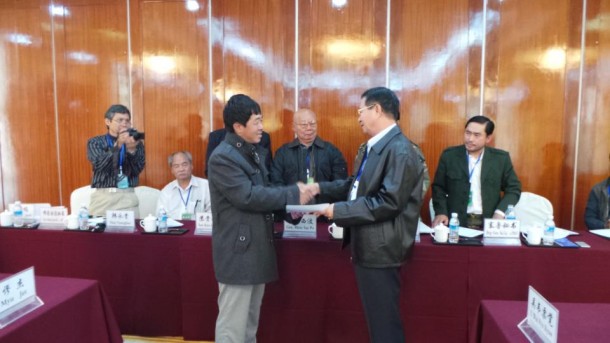A meeting between Burmese government peace negotiators and their Kachin counterparts in the Chinese city of Ruili on Monday has reopened channels of communication between the two sides, but has done little to improve the situation of the ground, say observers.
The meeting, the first since Oct. 30 of last year, aimed to ease tensions after months of intense fighting between government troops and the military wing of the Kachin Independence Organization (KIO). However, a joint statement released after the meeting gave no sign that the conflict was near an end.
The statement, published in the state-run New Light of Myanmar, said that the talks “focused on establishing communication channels, reducing military tension, preparing for next talks and the invitation of observers and organizations as witnesses in the next meeting.”
According to the statement, the two sides have agreed to hold their next round of talks before the end of February after coordinating with the United Nationalities Federal Council (UNFC), an ethnic alliance to which the KIO belongs.
While the meeting was welcomed by some as an important step toward resolving a conflict that began in June 2011, others expressed disappointment that it did not achieve more.
“They just agreed to meet again before the end of February. We can’t say it is a true improvement,” said Khon Ja of the Rangoon-based Kachin Peace Network, a humanitarian organization that assists civilians displaced by the war in Burma’s north.
Noting that on Sunday, the day before the talks, Burmese troops burned down a captured Kachin rebel outpost near Hpakant, she added that she saw no real prospect for peace as long as the government keeps sending more troops into the conflict zone.
“I can’t help getting the impression that they [the government] are ganging up against the Kachins, to force them to agree to just another ‘ceasefire’ without any political pledges,” Khon Ja told The Irrawaddy on Tuesday.
What the KIO wants, she said, is a political dialogue, and not just another ceasefire that offers no guarantees of a lasting settlement or security for the tens of thousands of civilians forced to flee government offensives.
The KIO previously signed a ceasefire agreement in 1994, but it broke down after 17 years when the government army attacked troops belonging to the group’s military wing, the Kachin Independence Army.
Despite the misgivings of observers hoping for more progress, however, the KIO sounded upbeat about the meeting on Monday, in part because it was hosted by the Chinese authorities and attended by witnesses from another prominent ethnic armed group, the Karen National Union (KNU).
“I think it was a good and positive sign,” said James Lum Dau, the deputy chief of the KIO foreign affairs section. He added that it is too early to comment on whether he is satisfied with the results of the meeting.
A total of around 30 people attended the meeting, including Chinese officials, peace brokers such as Hla Maung Shwe, and Gen Mutu Say Poe, the chairman of the KNU, which last year reached its first ever ceasefire agreement with the government after more than six decades of fighting for greater autonomy.
















